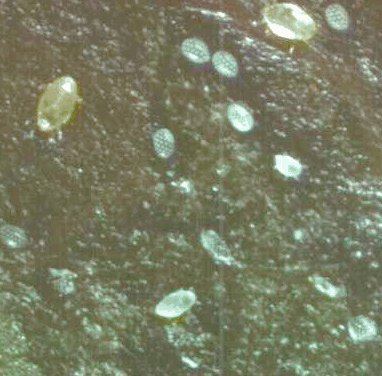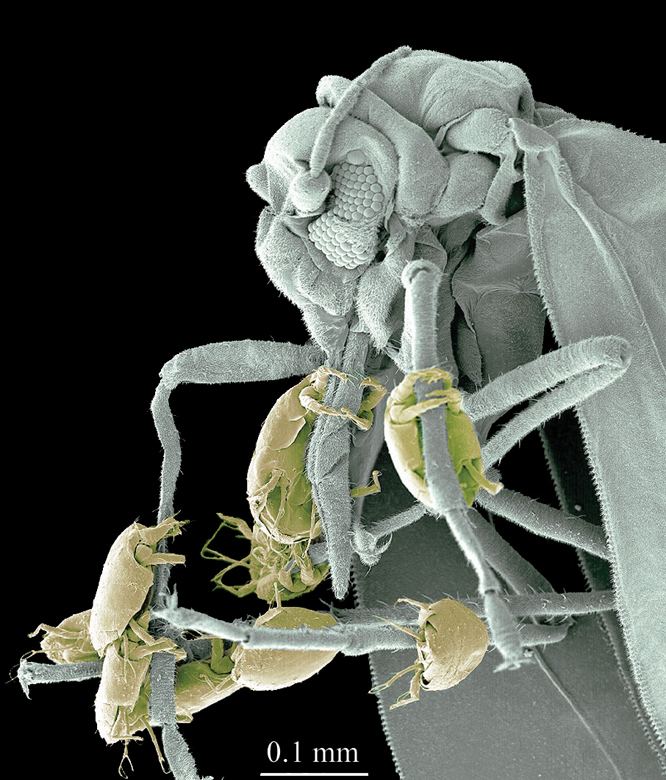didnt read through the whole thing but have you 100% identified them as russets?
there are also broad and cyclamen mites to consider
one reason they are so hard to control is that they live in the meristematic (sub dermal) tissue area making most topicals ineffective
a miticide with tansmaccular properties is preferred (one that concentrates the toxins into the growing tips of the plant)
they overwinter very well and other pesticides commonly used can increase egg production by as much as 25% (spectracide - merit aka immadicloprimid)
I attached a pdf that shows what miticides are effective for which mites, the ones that are compatible to use in a rotation and which ones kill eggs - it is very important to use at least one product that is effective on eggs
best to do a 3 product rotation 5-7 days apart using each product only once at the rate on the label - I have seen
avid -
forbid - pylon rotation used successfully on juvenile (well rooted established clones) - this was a broad mite infestation where the guy thought he had "plant aids" (he made that shit up - lol) - it is imperative you use the correct miticide and only use it ONE time - you may have created super mites throwing so many different cures at the problem
the other big key (and the one that is often overlooked) is ridding the grow - anything that cant be bleached or power washed should get tossed - fresh paint on all surfaces etc
repost:
Examining Broad Mites
- This is a revised article of our early 2012 WT Post. Please note that these issues were mainly occurring during 2011 and the high percentages of infestations taking place have died down substantially. Some information here is sourced, some information is directly from P.O. And it’s breeders / members.
There has been a fluctuation of posts regarding “TMV/Virus/Disease” related issues hitting various cannabis cultivation forums in 2011. We thought we would share all of the information we, and our friend Oswizzle have managed to gather regarding those issues.
Although this was a new problem to Southern California, this issue has been commonly occurring in Northern California and other parts. The issues initially started in late 2009 where a large amount of forum subscribers on” ICMAG” and other dominant forums began posting a new plant “virus” they couldn’t deal with. These so called “Virus” scares commonly turned out to be “Broad Mites”. As this was a new issue at the time, we’ve collected an extensive amount of information and thought we’d share it with our members and patients. These Broad Mites can be taken care of simply by being treated as one would treat Spider Mites or any pest infestation. Please, all growers take the time to read the information below extensively as it will save you time and increase your cultivation knowledge substantially.
Broad Mite damage exhibits the following signs (Remember many issues exhibit these signs so please don’t assume Broad Mites without checking thoroughly with a microscope):
- Yellowing Tops
- Slow / Stunted Growth
- Curling of the leaves (More often concentrated on new growth)
- Pale stem hue
- Blotches / Destroyed Pistils
Many of these signs are being associated with TMV/CMV (Tobacco/Cucumber Mosaic Virus), we personally warn against this train of thought due to the lack of respected sources (i.e. Reputable scientifically thorough organizations). None have stated discovery that TMV/CMV exists in Cannabis Plants, we went forth and studied “Infected plants” brought to us by members and found results that state similarly, no TMV/CMV has been discovered, at least not in the plants individuals assumed were infected. From the tests we, and our personal friends conducted (with a scientific approach / tools) no signs leaning towards TMV were found, only a variety of mites and nutrient / genetic related issues.
Below are pictures of Broad Mites.
- Broad Mites tend to only infect non hygienic growing environments as they have a hard time initially colonizing in a perfect, clean environment. Once Broad Mites are allowed to colonize, they will cling on for dear life and be a growers worst nightmare until they are thoroughly treated. When a plants defenses and immune system are weakened it could exhibit signs that are quite similar to the results of a mosaic virus infestation, however, the Broad Mites are treatable and will not progress to destroy the plant as a Mosaic Virus would.
If you are experiencing growth that is similar to these pictures, there is a chance you are dealing with Broad Mites. These mites are extremely small and cannot be seen with the naked eye, or a sub-par microscope.
Below is a picture that will give you a visual reference point to the size of Broad Mites. These Broad Mites are sitting atop a White Fly.
Here is thorough information that will take you through the A-Z of Broad Mites so that you may have a full understanding of their behavior patterns, appearances and signs they exhibit.
- Broad Mites or cyclamen Mites.
(Order: Acari, Family: Tarsonemidae, Polyphagotarsonemus latus.
Description:
Adult: Adults are very tiny with the female body length of 0.2 to 0.3 mm and males about half the size of females. Adults are broadly oval and whitish to yellow-green but appear somewhat translucent except under extreme magnification. They have four pair of legs, with the front two pair widely separated from the posterior two pair. The last pair of legs appears threadlike.
Immature stages: The appearance of the egg is the key characteristic generally used to verify plant infestations by broad mites. The eggs are nearly transparent with the exception of rows of whitish circular projections that give the eggs a speckled appearance. The larval and pupal stages appear similar to the adults but are smaller. The larval stage has six legs and the pupal stage has eight legs.
Biology:
Life cycle: Adults move short distances by walking, but are dispersed long distances by wind or by attaching to and ‘hitch-hiking’ on winged insects such as aphids and whiteflies. Eggs are laid singly on the lower surface of young apical leaves and flowers. Average egg production is reported as 40 to 50 eggs per female. Eggs hatch is about two days and the larval and pupal development requires a total of 2 to 3 days. Adult males emerge first and will carry female pupae to younger tissues. Females emerge and generally mate immediately. Unmated females produce only males which may then mate with the female, assuring production of subsequent females. The entire life cycle requires about one week under favorable conditions and typically occurs in the youngest terminal growth. Broad mites are generally not found on fully opened leaves.
Seasonal distribution: Broad mites have a wide host range and can occur throughout the year in tropical climates. Reproduction does not occur below 13°C nor above 34 degrees. Temperatures of about 25°C and humid conditions are most favorable. Cold winters and hot, dry summers usually limit populations in Georgia. Rainy fall seasons provide optimal conditions for broad mites in south Georgia, and the greatest damage usually occurs at these times.
Damage to Crop:
Broad mite has a large host range including 60 families of plants (including Cannabis). Its vegetable hosts include beet, beans, cucumber, eggplant, pepper, potato and tomato. Damage is especially severe in bell pepper. Damage is caused by secretion of a plant growth regulator or toxin as the mite feeds, and significant damage can occur at very low pest density. Symptoms include leaf and fruit distortions, shortening of internodes, blistering, shriveling and curling of leaves, and leaf discoloration.Much of this can be easily confused with viral disease, micronutrient deficiency, or herbicide injury. Fruit may be deformed, split, or russeted. Infestations in pepper can cause a bronzing of terminal growth and are frequently associated with a characteristic ‘s’-shaped twisting of the main stem in leaves. Damage may appear for weeks after the mites have been controlled, and when combined with the difficulty in detecting mites, makes evaluation of control measures difficult and has likely led to reports of control failures.
Management:
The broad mite’s minute size and ability to damage plants at very low densities generally results in plant injury serving as the first indication of an infestation. When damage is noted, terminals of symptomatic plants should be examined under magnification to verify the presence of broad mites. Damage will usually start in small clumps in a field and can spread rapidly. Some acaricides provide excellent control, but examination of plant terminals is necessary to evaluate control success, as damage can continue to appear for two weeks after successful control.
Generalized Summary:
Adult - The adults are white-yellow, about 0.2 mm long, and the male is extremely active.
Immature stages - Eggs laid on the underside of leaves are oval, translucent and covered with five or six rows of white tubercles.
Life history - The life cycle through egg, two nymphal stages, to adult takes between 6 to 9 days.
Damage
Broad mite attacks the growing point and the underside of young leaves causing hardening and distortion. Broad mite damage is often confused with injury caused by hormone herbicides because in both cases the leaves become claw-like with prominent veins. Grey or bronze scar tissue between the veins on the underside of the leaves distinguishes mite from hormone damage. Broad mite infestation can sometimes be confirmed with a X 10 hand lens although they have often disappeared before the damage is noticed. The characteristic egg can be seen near the veins beneath the leaf as a translucent, flat oval with a stippling of white dots. The mite itself is flat but is less easily identified than its egg.











